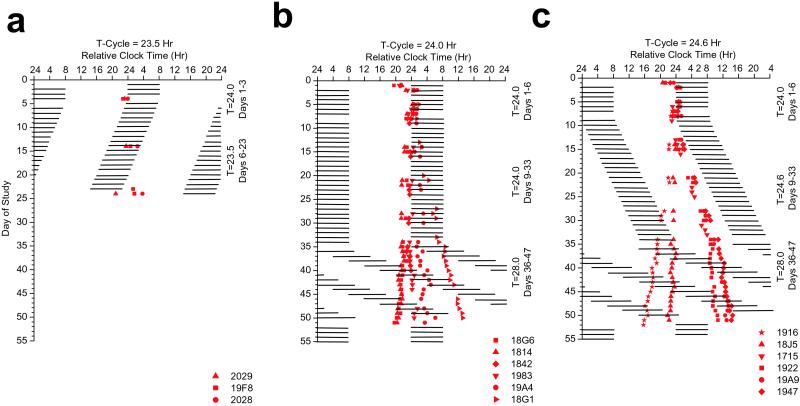Figure 1.
Melatonin onset (DLMO25%) times. (a) Subjects scheduled to the 23.5-h day. Data are plotted to a relative clock time with lights out assigned a value of 2400 h on baseline day 1. Black bars represent scheduled sleep. During the imposed 23.5-h segment, lights out and lights on are advanced by 30 min each day. Melatonin onset occurred near to, but advanced relative to, lights out for the subjects during baseline days, whereas during T = 23.5-h days, melatonin onset progressively phase delays relative to lights out. These data demonstrate failure to entrain the circadian pacemaker to the scheduled 23.5-h wakefulness–sleep light–dark cycle. (b) Subjects scheduled to the 24.0-h day. During the imposed 24.0-h segment, melatonin onset appears stable and occurs near to, but advanced relative to, lights out for half of the subjects and delayed for the other half. These data demonstrate that most subjects entrained to the 24.0-h day with a new phase angle, as would be expected to occur in response to the weak environmental synchronizer. A greater dispersion of melatonin onsets can be observed during forced desynchrony, reflecting individual differences in intrinsic circadian period. In two of six subjects, circadian period advanced and in the remaining subjects circadian period delayed during forced desynchrony (Table 1). Subject 18G1 failed to entrain to the 24.0-h day. (c) Subjects scheduled to the 24.6-h day. During the imposed 24.6-h segment, lights out and lights on are delayed by 36 min each day. Melatonin onset occurs near to, but advanced relative to, lights out for half of the subjects and delayed for the other half during baseline days, whereas during the 24.6-h segment, melatonin onset is progressively phase advanced relative to lights out. These data demonstrate a failure to entrain the human circadian pacemaker to the scheduled 24.6-h day. Individual differences in intrinsic circadian period result in a large dispersion of melatonin onsets during the T = 24.6- and T = 28.0-h forced desynchrony protocols.

